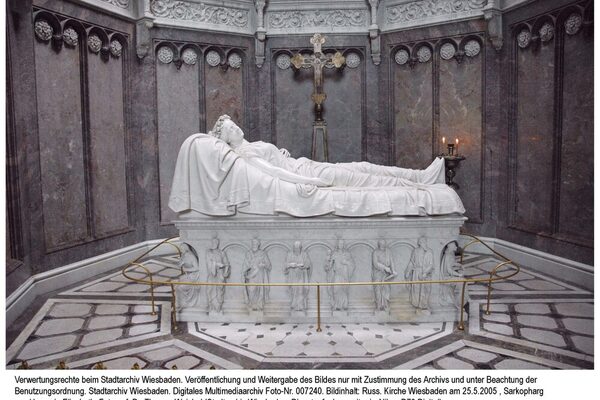Elisabeth Duchess of Nassau, née Elizaveta Mikhailovna Romanova, Grand Duchess of Russia
Elisabeth Duchess of Nassau, née Elizaveta Mikhailovna Romanova, Grand Duchess of Russia
born: 26.05.1826 in Moscow
died: 28.01.1845 in Wiesbaden
Through her father, Elisabeth was the granddaughter of Tsar Paul I and niece of Tsars Alexander I and Nicholas I. Her first meeting with her future husband Duke Adolph zu Nassau took place in Bad Ems in the summer of 1840. A marriage was already being considered at that time. Three years later, they met again in Baden Baden. The marriage was finally decided after Adolph had obtained permission during a brief visit to Tsar Nicholas I in the summer of 1843. The marriage contract was signed in Moscow in December 1843. Among other things, it stipulated that Elisabeth would be allowed to keep her Orthodox faith even after moving to Nassau. A house church was to be set up in her residence for this purpose. Her dowry was set at one million silver rubles, as was customary for the granddaughters of tsars. Elisabeth was allowed to freely dispose of the interest yield of four percent for the rest of her life. The wedding took place on January 31, 1844 in St. Petersburg. Elisabeth was 17 years old, Adolph already 26. The couple stayed in Russia until the end of February and then traveled to Nassau via Weimar. The whole of Wiesbaden celebrated the couple's arrival on 26.03.1844.
Elisabeth, now Duchess of Nassau, devoted herself to charitable projects and, among other things, founded the Elisabeth Sanatorium, which was merged with the Paulinenstift in 1899. She died after less than a year of marriage during the birth of a daughter, who also did not survive; the cause of death was advanced tuberculosis.
The deceased were first buried in the Orthodox house church in Rheinstraße, then in the Mauritius Church. When this burned down in 1850, the coffins were transferred to a side chapel of the Catholic Boniface Church. They found their final resting place in 1855 in the Russian Church on the Neroberg, which had been built with funds from Elisabeth's dowry at the request of the mourning duke and in accordance with the tsar's will. Elisabeth's cenotaph in a semi-circular extension on the north side was created by the sculptor Emil Hopfgarten from white Carrara marble. In Wiesbaden, three Elisabeth streets in Biebrich, Delkenheim and Kastel commemorate the duchess.
Literature
Even, Pierre: The Luxembourg-Nassau dynasty. From the Counts of Nassau to the Grand Dukes of Luxembourg. A nine-hundred-year history of rulers in one hundred biographies, Luxembourg 2000 [pp. 210-214].
Vershevskaya, Marina: Graves tell history. The Russian Orthodox Church of St. Elisabeth and its cemetery in Wiesbaden, Wiesbaden 2007 [pp. 16-43].
